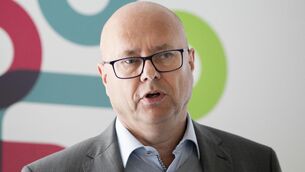Paul Hosford: Coalition's legacy will rest on its Housing for All strategy

Taoiseach Micheál Martin, Environment Minister Eamon Ryan, Tánaiste Leo Varadkar, and Housing Minister Darragh O'Brien pictured earlier today. The fate of their coalition rests on whether the new plan properly resolves Ireland's chronic housing problems. Picture: Maxwells/PA
The Housing For All document launched on Thursday may be the most important policy the Coalition will publish.
Running to 160 pages, it lays out how the Government aims to tackle the largest social issue facing the country, an issue which was cited as one of the two most important factors in voters' decisions at the last general election.
Committing to seeing 300,000 homes built in the next nine years, the document sets out widespread changes to how the housing system is governed and financed, and speaks of sweeping changes to the rules around planning, councils, and state bodies.
The document commits to building 90,000 social homes, as well as 36,000 affordable-purchase, 18,000 cost-rental, and 156,000 private purchase or rental homes.
The Government wants to reach 33,000 homes built per year by 2025 — that is 12,000 more than the total built in 2019, the last full year before the Covid-19 pandemic hit.
That will work out yearly as 10,000 social, 4,000 affordable purchase (including 2,000 homes under the shared equity scheme up to 2025), 2,000 cost-rental, and 17,000 private homes.
However, the opposition has criticised it as pro-developer, not ambitious enough, and of reheating old announcements. That criticism sets the scene for the political battle which will define this Government.
Having pushed to take on the housing portfolio in this Government, Fianna Fáil backed itself as a party to solve the domestic policy crisis of our time. Across Government, there is an acknowledgement that whatever the achievements of the Coalition, it will be considered a failure if it does not solve the issue of housing.
Housing Minister Darragh O'Brien, to his credit, understands this. The question, however, is not whether Mr O'Brien can grasp the severity of the problem, it's about whether he and his Government can do what has to be done to fix it.
The plan launched yesterday, after a delay due to Cabinet wrangling, is a lengthy explanation of not just what the Government's targets are, but how they will be funded and achieved. Full of images of home construction and pictures of cranes, it is ambitious and glossy — but then, so was its predecessor, Rebuilding Ireland.
There are hopes, however, that this time is different, and many political legacies will be resting on just that.
For his part, the Dublin Fingal TD is aware that a document alone will not put homes around people and has sought to solve the problems in the housing sector in the round, enacting the Affordable Housing Act and putting the Land Development Agency (LDA) on a statutory footing, as well as enacting a number of pieces of legislation around renting. If there is a message to take from the document it is this — there is no silver bullet.
And the fact that there is not one easy answer comes down to the political decisions made over the last 20 years, but mostly over the last decade as the financial crash decimated the construction sector and the decision was made for the State not to intervene.
While Housing For All aims to get to 33,000 new homes built a year, it is important to remember that, as recently as 2013, that figure was at 4,575.
Mr O'Brien signalled that that era, of a hands-off approach to the overall market, is over. Housing For All is to mark a new approach — what Mr O'Brien calls "a massive expansion in the role of the State in providing affordable homes for purchase and rent".
Housing for All is not just a new plan, then. It is a new way of doing business for the Government, one that puts state interventions close to the centre of housing.
But there are still major worries about the fact that 156,000 of the homes earmarked will be built by the private sector, something which the State has no ability to guarantee.
There are concerns, too, that the plans merely dress up unaffordable homes to put them within reach of middle income earners. Take for example the local authority affordable purchase scheme.
It will sell homes to people at an average cost of €250,000. But only because the local authority takes an equity stake of up to 30% or €100,000. The purchaser can redeem or buy out this equity stake at a time of their choosing, but there will be no requirement to do so. Is making things more affordable in this way real affordability? Will locked-out homeowners care?
While the debate about the words on the paper rages, those in Fianna Fáil will be keenly aware that talk is the one thing in housing that is cheap.
What will matter now is action — the country, and this Government, is counting on it.












